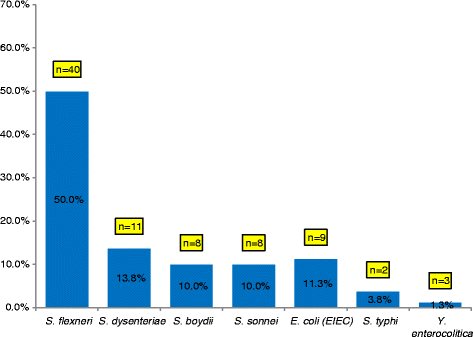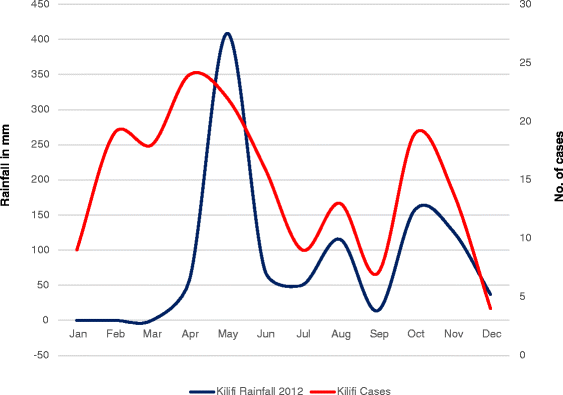Enteric pathogens and factors associated with acute bloody diarrhoea, Kenya
- PMID: 27600526
- PMCID: PMC5012060
- DOI: 10.1186/s12879-016-1814-6
Enteric pathogens and factors associated with acute bloody diarrhoea, Kenya
Abstract
Background: Shigellosis is the major cause of bloody diarrhoea worldwide and is endemic in most developing countries. In Kenya, bloody diarrhoea is reported weekly as part of priority diseases under Integrated Disease Surveillance and Response System (IDSR) in the Ministry of Health.
Methods: We conducted a case control study with 805 participants (284 cases and 521 controls) between January and December 2012 in Kilifi and Nairobi Counties. Kilifi County is largely a rural population whereas Nairobi County is largely urban. A case was defined as a person of any age who presented to outpatient clinic with acute diarrhoea with visible blood in the stool in six selected health facilities in the two counties within the study period. A control was defined as a healthy person of similar age group and sex with the case and lived in the neighbourhood of the case.
Results: The main presenting clinical features for bloody diarrhoea cases were; abdominal pain (69 %), mucous in stool (61 %), abdominal discomfort (54 %) and anorexia (50 %). Pathogen isolation rate was 40.5 % with bacterial and protozoal pathogens accounting for 28.2 % and 12.3 % respectively. Shigella was the most prevalent bacterial pathogen isolated in 23.6 % of the cases while Entamoeba histolytica was the most prevalent protozoal pathogen isolated in 10.2 % of the cases. On binary logistic regression, three variables were found to be independently and significantly associated with acute bloody diarrhoea at 5 % significance level; storage of drinking water separate from water for other use (OR = 0.41, 95 % CI 0.20-0.87, p = 0.021), washing hands after last defecation (OR = 0.24, 95 % CI 0.08-.076, p = 0.015) and presence of coliforms in main source water (OR = 2.56, CI 1.21-5.4, p = 0.014). Rainfall and temperature had strong positive correlation with bloody diarrhoea.
Conclusion: The main etiologic agents for bloody diarrhoea were Shigella and E. histolytica. Good personal hygiene practices such as washing hands after defecation and storing drinking water separate from water for other use were found to be the key protective factors for the disease while presence of coliform in main water source was found to be a risk factor. Implementation of water, sanitation and hygiene (WASH) interventions is therefore key in prevention and control of bloody diarrhoea.
Keywords: Acute bloody diarrhoea; Case; Control; Enteric pathogens; Factors; Kilifi; Nairobi.
Figures



Similar articles
-
Correlates of multi-drug non-susceptibility in enteric bacteria isolated from Kenyan children with acute diarrhea.PLoS Negl Trop Dis. 2017 Oct 2;11(10):e0005974. doi: 10.1371/journal.pntd.0005974. eCollection 2017 Oct. PLoS Negl Trop Dis. 2017. PMID: 28968393 Free PMC article.
-
Characterization and factors associated with diarrhoeal diseases caused by enteric bacterial pathogens among children aged five years and below attending Igembe District Hospital, Kenya.Pan Afr Med J. 2013 Oct 4;16:37. doi: 10.11604/pamj.2013.16.37.2947. eCollection 2013. Pan Afr Med J. 2013. PMID: 24570797 Free PMC article.
-
Bloody diarrhoea cases caused by Shigella and amoeba in Jordan.New Microbiol. 2004 Jan;27(1):37-47. New Microbiol. 2004. PMID: 14964404
-
Aetiology of diarrhoea in children aged zero to nine years in low- and middle-income countries: A systematic review.J Glob Health. 2024 Nov 1;14:04168. doi: 10.7189/jogh.14.04168. J Glob Health. 2024. PMID: 39485019 Free PMC article.
-
Interventions to improve disposal of child faeces for preventing diarrhoea and soil-transmitted helminth infection.Cochrane Database Syst Rev. 2019 Sep 24;9(9):CD011055. doi: 10.1002/14651858.CD011055.pub2. Cochrane Database Syst Rev. 2019. PMID: 31549742 Free PMC article.
Cited by
-
Molecular detection of Coxiella burnetii in ticks infesting wild and domestic animals in the Eastern region of Punjab, Pakistan.Trop Anim Health Prod. 2024 Sep 3;56(7):252. doi: 10.1007/s11250-024-04087-8. Trop Anim Health Prod. 2024. PMID: 39225870
-
Epidemiological investigation and management of bloody diarrhea among children in India.PLoS One. 2019 Sep 13;14(9):e0222208. doi: 10.1371/journal.pone.0222208. eCollection 2019. PLoS One. 2019. PMID: 31518363 Free PMC article.
-
Health worker knowledge of Integrated Disease Surveillance and Response standard case definitions: a cross-sectional survey at rural health facilities in Kenya.BMC Public Health. 2018 Jan 17;18(1):146. doi: 10.1186/s12889-018-5028-2. BMC Public Health. 2018. PMID: 29343225 Free PMC article.
-
Prevalence and Antimicrobial-Resistant Features of Shigella Species in East Africa from 2015-2022: A Systematic Review and Meta-Analysis.Interdiscip Perspect Infect Dis. 2023 Sep 2;2023:8277976. doi: 10.1155/2023/8277976. eCollection 2023. Interdiscip Perspect Infect Dis. 2023. PMID: 37692062 Free PMC article. Review.
-
Shigellosis in an Urban Slum in Kenya: Risk Factors and Antimicrobial Resistance.Open Forum Infect Dis. 2025 Jan 18;12(2):ofaf026. doi: 10.1093/ofid/ofaf026. eCollection 2025 Feb. Open Forum Infect Dis. 2025. PMID: 39963694 Free PMC article.
References
-
- UNICEF. WHO . Diarrhoea: Why children are still dying and what can be done. 2009. - PubMed
-
- Jafari F, Shokrzadeh L, Hamidian M, Salmanzadeh-Ahrabi S, Zali MR. Acute diarrhea due to enteropathogenic bacteria in patients at hospitals in Tehran. Jpn J Infect Dis. 2008;61(4):269–73. - PubMed
-
- WHO . Guidelines for the control of shigellosis, including epidemics due to Shigella dysenteriae type 1. Geneva: World Health Organization; 2005.
-
- Aklilu A, Kahase D, Dessalegn M, Tarekegn N, Gebremichael S, Zenebe S, et al. Prevalence of intestinal parasites, salmonella and shigella among apparently health food handlers of Addis Ababa University student inverted question marks cafeteria, Addis Ababa, Ethiopia. BMC Res Notes. 2015;8(1):17. doi: 10.1186/s13104-014-0967-x. - DOI - PMC - PubMed
MeSH terms
Grants and funding
LinkOut - more resources
Full Text Sources
Other Literature Sources
Medical

